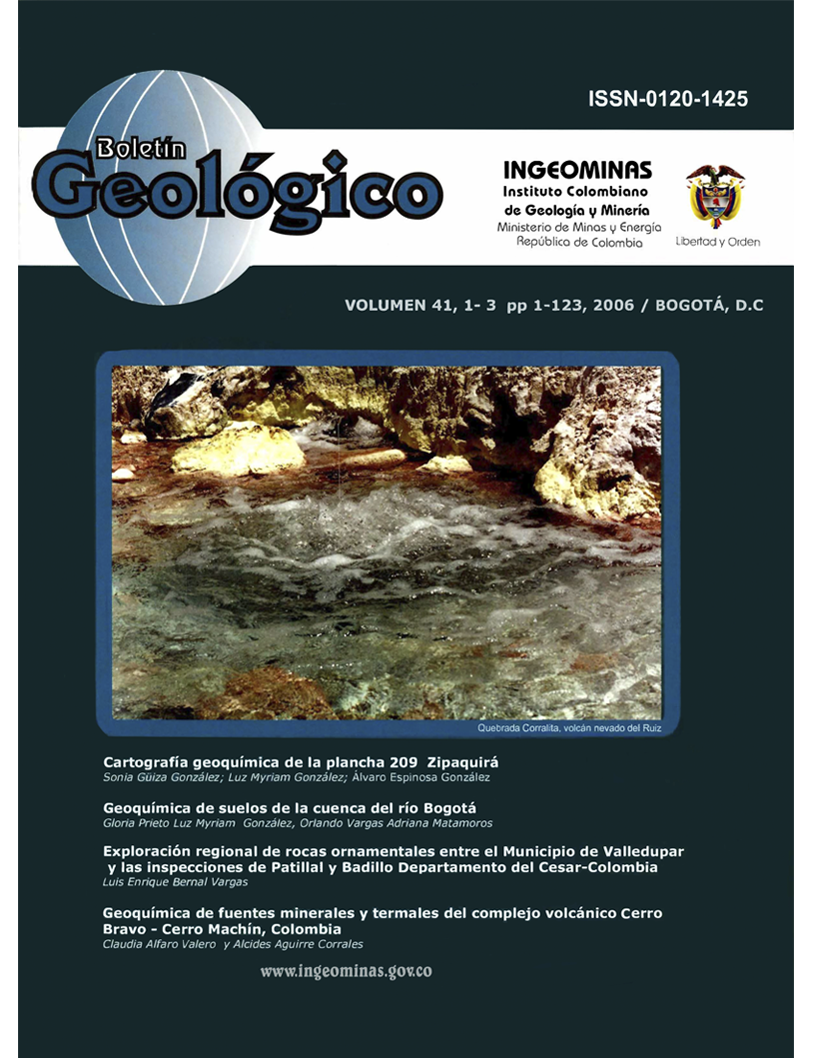Soil geochemistry of the Bogotá River Basin
DOI:
https://doi.org/10.32685/0120-1425/boletingeo.41.2006.156Keywords:
soils, heavy metals, potentially dangerous elements, Bogotá, river basin, geochemistryDownloads
How to Cite
Issue
Section
Published
Abstract
In arder to study environmental geochemical processes in the Central Region of Colombia, the geochemistry project of Ingeominas, carried out a systematic geochemical sampling programme in soils a long the Bogotá River basin. The sampling program was carried out based on a bi-dimensional net (5x5km cells), collecting one sample per 25 km2 and one cell duplicate sample per 100 km2. 273 samples of superficial soil (A0-25) and Chorizan (up to 2m depth) were collected.
In the INGEOMINAS laboratories pseudototal contents of Cd, Pb, Zn, Mo, Mn, As, Cr, Co, Cu and Ni were determined (aqua regia and multi-acid digestion/ICP-AES); and in Activation Laboratories of Canada 48 elements were measured (multi-acid digestion/ICP-AES; INAA).
This paper presents results of As, Cd, Co, Cr, Cu, Mn, Mo, Ni, Pb, and Zn in the superficial horizon (A0-25) of the soil samples, including sorne data generated far previous projects carried out far INGEOMINAS in this region. The data were processed statistically and geo-statistically, dots and distribution maps by element were constructed.
Geochemical patterns allow differentiating two main zones. First zone covers the high basin of the Bogotá river including the Savannah of Bogotá, and the Capital City, the soils have acidic pH (pH 4-6,5), textura! variability and relatively low concentration of elements with the exception of sorne places in the middle basin. Second zone, comprises the low river basin, the soils have more basic pH (pH 6,6-9), texture predominantly argillaceous and high contents of trace elements.
Statistically three associátion groups were differentiated: group 1: As, Cd, Cu, Cr, Mo, Ni and Zn; group 2: Co and Mn and group 3: Pb, not displaying significant correlation with any other element. These groups correspond to natural geochemical associations characteristic of sedimentary rocks. They represent also common associations of residues of activities such us industry, agriculture and transport. Lead behaviour, on the other hand seems to indicate mainly anthropic origin (old leaded gasoline and industrial emissions).
The systematic soil sampling carried out along the Bogotá River basin, allowed to determine accumulation levels of potentially harmful elements, to discriminate possible origin and to analyze parameters and factors that determine local mobility and bio-availability of these elements. This information contributes to the geochemical base lines definition, is basic to soil use planning and is support to the Bogotá River basin management.
References
Acosta, J., Ulloa, C, 1996. Memoria explicativa de la geología de la plancha 208 Villeta. INGEOMINAS. Bogotá.
Acosta, J., Ulloa, C. 1997. Memoria explicativa de la geología de la plancha 227 Bogota Nor-occidente. INGEOMINAS, Informe 2302. Bogotá.
Acosta, J., Ulloa, C. 1998. Geología de la plancha 246, Fusagasuga. INGEOMINAS, Informe 2374. Bogotá.
Acosta J., Guatame, R., Caicedo, J., Cardenas, J. 2000. Geología de la plancha 245, Girardot. INGEOMINAS, Informe 2474. Bogotá. CAR, 2000. Manejo integral de cuencas, cuenca hidrográfica del río Bogotá. Un CD. Bogotá.
IGAC, 2000. Estudio general de suelos y zonificación de tierras del departamento de Cundinamarca. Bogotá. INGEOMINAS, 1997. Mapa geológico de Colombia. Bogotá D.C.
González, LM., Vargas, O. 2004. El problema de la contaminación de los suelos por metales pesados. En: Aspectos geoambientales de la Sabana de Bogotá. Publicación Especial No. 27. INGEOMINAS. Bogotá.
González, LM., Vargas, O. 1997. Estudio de la movilización de contaminantes en suelos de la Sabana de Bogotá. INGEOMINAS. Informe Interno. Bogotá, 1997.
Montoya, D., REYES, G. 2003. Geología de la plancha 209, Zipaquirá. INGEOMINAS. Informe interno. Bogotá.
Kabata Pendias and Pendias. 2000. Standards for the assessment of soil and crop pollution with heavy metals as a guideline for agricultura! land use. USGS, 2001. Metals in continental soils. Washington D.C.
Van der hammen, T. 1998. Plan ambiental de la cuenca alta del río Bogotá: análisis y orientaciones para el ordenamiento territorial. CAR. Bogotá.
Vrom, 1991. Environmental quality standards for soils and water, Ministry of Housing, Physical Planning and Environment. The Hague.









